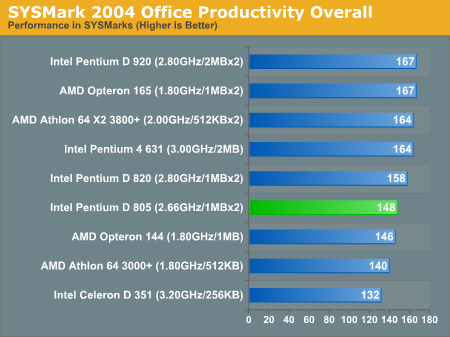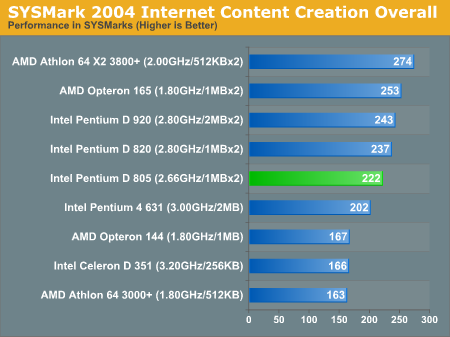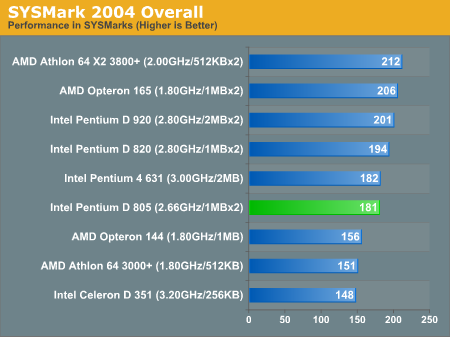Intel Pentium D 805 - Dual Core on a Budget
by Anand Lal Shimpi on April 7, 2006 12:00 AM EST- Posted in
- CPUs
Overall Performance using SYSMark 2004

In the Office Productivity suite of SYSMark 2004 you see a similar picture of the AMD/Intel rivalry to what we saw in MMCC Winstone, with the Pentium D 805 offering performance slightly faster than that of the single core Athlon 64 3000+ and Opteron 144. The Pentium D 820 really starts to show its worth here, offering an almost 7% performance advantage over the 805.

SYSMark's Internet Content Creation tests are dominated by the Athlon 64 X2 3800+, but the Pentium D 805 also does exceptionally well for its price. Here we see about a 36% increase in performance over the similarly priced Athlon 64 3000+. A major reason for the performance improvement due to dual core/Hyper-Threading in this test is because ICC SYSMark 2004 will actually trigger one of those dreaded appllication stalls when multitasking and switching between two applications. Having a Hyper-Threading enabled or dual core CPU alleviates the problem and lets things move a lot smoother. There are obviously other performance benefits to dual core, but SYSMark actually offers us a way of measuring what is normally a very unquantifiable benefit of dual core CPUs.

The overall picture in SYSMark is pretty good for the Pentium D 805: it shows the processor offering greater performance than its AMD cost-competitor, and about 93% of the performance of the Pentium D 820. Interestingly enough, SYSMark on average shows the Pentium D 805 basically equalling the performance of the single core Pentium 4 631.










51 Comments
View All Comments
Nick5324 - Friday, April 7, 2006 - link
Agree, good stuff! I'm looking forward to the overclocking write up.whitelight - Friday, April 7, 2006 - link
i liked how you included a large variety of cpu's. thanks!lifeblood - Friday, April 7, 2006 - link
Having read all the reviews of EE this and XF that, I was starting to think my poor little +3000 was ready for the garbage heap. After reading this article I was very happy to see my +3000 still does quite well in office productivity and games which is it's primary use. I guess I will keep it around another year before upgrading to an X2.PrinceGaz - Friday, April 7, 2006 - link
Superb article Anand, this is the kind of article I like; a test that includes all of the likely alternative chips that might be considered and where something useful is said under each graph instead of just presenting page after page of graphs with no comments. Okay so I look at the graphs first and make my own mind up, but it's always good to see what someone else thinks in each test to see if I missed something important. I look forward to more articles like this; hopefully the Pentium D 805 overclocking article will also look at overclocking the other chips, not just the 805.The one error I refer to is that although the Celeron D processor is correctly identified as having 256KB L2 cache in pages 2 and 3 of the article, on all of the graphs (page 4 onwards) it says 512KB. Shouldn't take long to fix.
Dfere - Friday, April 7, 2006 - link
I liked the article- not for the graphs. I rad the beginning, some of the set up and the conclusions, and the comments. I am not a tech head! I agree it is nice to get a broad based analysis/market comparison, especially on the "value" segment orbusiness stuff. (CPA here).JarredWalton - Friday, April 7, 2006 - link
Fixed, thanks! (Not as easy to correct as you might suspect... graphs require a bit more effort, but at least it was only one change per graph.)YellowWing - Friday, April 7, 2006 - link
No mention of 64 bit support in the 805, is 64 bit possible?Viditor - Friday, April 7, 2006 - link
Yes...
FSB = 533 MHz
Cache = 2x1MB
Clockspeed = 2.66 GHz
Virtualization = No
Enhanced Speed Step = No
EM64T = Yes
YellowWing - Friday, April 7, 2006 - link
ThanksJackPack - Friday, April 7, 2006 - link
Yes, of course.